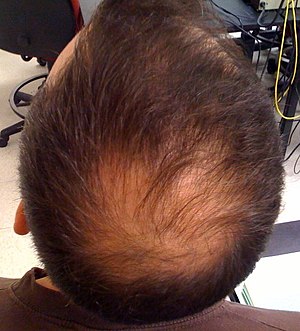Male-pattern baldness
| Pattern hair loss | |
|---|---|
| Synonyms | androgenic alopecia, androgenetic alopecia, male pattern baldness, female androgenic alopecia, female pattern baldness |
 |
|
| Male-pattern hair loss | |
| Classification and external resources | |
| Specialty | Dermatology, plastic surgery |
| ICD-10 | L64 |
| DiseasesDB | 7773 |
| MedlinePlus | 001177 |
| eMedicine | derm/21 |
| MeSH | D000505 |
Pattern hair loss, known as male-pattern hair loss (MPHL) when it affects males and female-pattern hair loss (FPHL) when it affects females, is hair loss that primarily affects the top and front of the scalp. In males the hair loss often presents as a receding hairline while in females it typically presents as a thinning of the hair.
Male pattern hair loss is believed to be due to a combination of genetics and the male hormone dihydrotestosterone. The cause in female pattern hair loss remains unclear.
Treatment may include simply accepting the condition. Otherwise treatments may include minoxidil, finasteride, or hair transplant surgery. Evidence for finasteride in women; however, is poor and it may result in birth defects if taken during pregnancy.
Pattern hair loss by the age of 50 affects about half of males and a quarter of females. It is the most common cause of hair loss.
Classic male-pattern hair loss begins above the temples and vertex, or calvaria, of the scalp. As it progresses, a rim of hair at the sides and rear of the head remains. This has been referred to as a 'Hippocratic wreath', and rarely progresses to complete baldness. The Hamilton-Norwood scale has been developed to grade androgenic alopecia in males.
Female-pattern hair loss more often causes diffuse thinning without hairline recession; similar to its male counterpart, female androgenic alopecia rarely leads to total hair loss. The Ludwig scale grades severity of female-pattern hair loss.
Research indicates that the initial programming of pilosebaceous units of hair follicles begins in utero. The physiology is primarily androgenic, with dihydrotestosterone (DHT) the major contributor at the dermal papillae. Men with premature androgenic alopecia tend to have lower than normal values of sex hormone-binding globulin (SHBG), follicle stimulating hormone (FSH), testosterone, and epitestosterone when compared to normal controls. Although follicles were previously thought permanently gone in areas of complete hair loss, they are more likely dormant, as recent studies have shown the scalp contains the stem cell progenitor cells from which the follicles arose. This however, only applies to non scarring hair loss, which preserves the hair follicles, unlike scarring hair loss, which completely destroys the hair follicles.
...
Wikipedia
